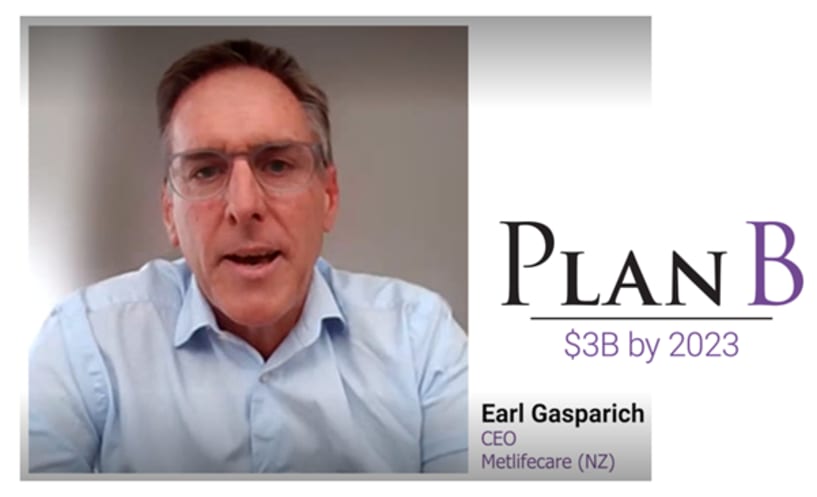About 15 years ago, the New Zealand village operators transformed their business model.
At that time they had 6% penetration of all people aged 70-plus living in villages. Now it is 14% nationally, and in some areas greater than 20%.
How did they achieve this?
The answer is simple:
“They said to the public if you want a ‘standard’ Government-funded aged care room and residential aged care experience, that is your choice and let the Government pay for it.
“But if you want a ‘premium’ residential aged care experience we will create that for, you but you will have to contribute on the cost of it.”
And ageing New Zealanders did and are.
The offer – and demand – has been so successful that virtually no aged care beds have been built outside of a retirement village in the past 10 years.
Earl Gasparich at the LEADERS SUMMIT
 Metlifecare CEO Earl Gasparich explained this history and the business model to the LEADERS SUMMIT audience.
Metlifecare CEO Earl Gasparich explained this history and the business model to the LEADERS SUMMIT audience.
Villages offer a continuum of care, from independent living to Serviced Apartments to residential aged care. And a village resident has priority on beds when they become vacant.
The Government pays $145 a day for low care service in the residential care model and around $240 for high care, or ‘hospital care’ as they call it.
This covers all care and accommodation when it is a ‘standard’ room – which is in most cases multi-bed wards and share toilets in freestanding aged care homes.
If the customer wants a single room with ensuite and extra services, they have to pay and the operators have the freedom to competitively price as they wish in the local market.
 This is where villages excel as their offering is not just the two years in an aged care home, but the last 10 years across the ageing journey. And this is now understood in New Zealand to be a great value proposition, especially for couples wanting certain outcomes for both.
This is where villages excel as their offering is not just the two years in an aged care home, but the last 10 years across the ageing journey. And this is now understood in New Zealand to be a great value proposition, especially for couples wanting certain outcomes for both.
Means testing in New Zealand and Plan B
Consumer aged care funding is means tested in New Zealand, including the family home. The threshold is wealth at $238,000. Above that, you have to contribute to the cost of care.
So most New Zealanders are forced to contribute.
 Specifically, unless your wealth is under $238,000, you have to contribute to the base $145 per day and you have to pay all of your accommodation costs – the operator price for the ‘premium room’ per day.
Specifically, unless your wealth is under $238,000, you have to contribute to the base $145 per day and you have to pay all of your accommodation costs – the operator price for the ‘premium room’ per day.
Those with reasonable wealth will pay the full $145 plus the say $60 a day for the premium room – a total of $205 per day or $75,000 a year.
The Government always pays the hospital care component of $230, less the $145 or $85 per day. This is another $85 per day the operator receives.
All up, this would total $290 per day or $105,850 per year.
Across Australia, the average return per bed is $71,000 per year, in most cases for a ‘premium’ room with ensuite.
Extra services can add up to $70,000 but a relatively small percentage of operators collect these fees.
Plan B, our strategy to achieve policy change that standardises co-contribution to the cost of home and residential aged care, will open this new channel of funding.
Co-contribution as a principal goes to adequately funding aged care to deliver quality.
It also goes to fairness; young Australians should not be called on to fund wealthy seniors for their accommodation and living expenses. (Funding the care old older Australians without the financial means is okay as it is a universal health obligation for the community).
And competition leads to variety of service models and choice for customers and their families.
We will discuss Plan B in more detail over the coming weeks.
As a side note, all New Zealanders over the age of 64 receive NZ Super, a payment of $87 a day. The Australian Single pension is $64 per day and is means tested.
Village value proposition, bed licenses & funding control
In his LEADERS SUMMIT discussion, Earl re-emphasised that the village value proposition is the continuum of care, from independent living to high care, on the one campus.
In July 2024, bed licenses become deregulated, meaning village operators can build aged care beds (with the qualification they are approved as an operator), and the Government gives control of funding to the customer – i.e., they fully control choice.
The last piece that the Australian sector needs to match New Zealand is Plan B, that customers recognise that if they want quality aged care, they will have to co-contribute.
With a successful Plan B, operators will then have the confidence to commit the capital to build a continuum of care and charge fair and competitive pricing.
Watch this space.










